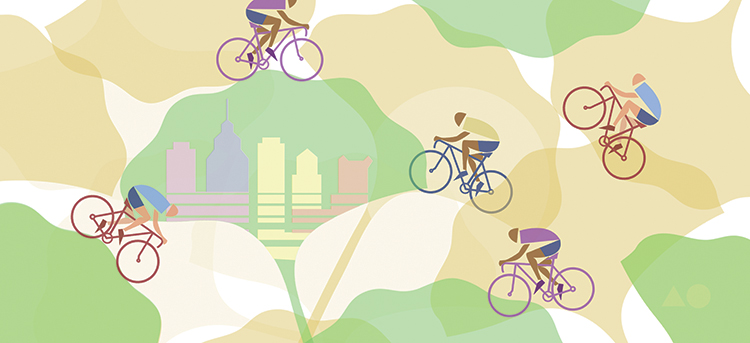Illustration by Corey Schumann
Trees of Life
interview by Heather Shayne Blakeslee
When historian Jill Jonnes sat down to write her book “Urban Forests: A Natural History of Trees and People in the American Cityscape,” it was with the intention of looking at our past relationship with trees in order to see into the future of combating climate change. Trees have always done hard work in cities, providing sanitation, shade, fresh air, stormwater mitigation, carbon storage, food, peace of mind and beauty—when our politicians have invested in them. ¶ The book is filled with American tree-lore backstories: The Arbor Day Foundation has to keep a low-profile on its pro-slavery founder; the first shipment of Washington, D.C.-bound cherry treesfrom Japan was burned due to infighting and a bug infestation; fan-leafed ginkgos first got here due to an arboreally covetous Philadelphian whose estate is now the Woodlands Cemetery.
Why do we love trees so much?
JJ: Well, we lived in trees—before we were humans. Once we began evolving into humans, we clearly still spent some time in trees, and I also think trees provide us many different kinds of services. If you think about living in a pre-industrial world: Trees provide shade; certain kinds of trees provide food; they provide wood, which means you can have fire. But probably the most important thing about trees is their aesthetic natural qualities. They’re very alive, and they live a long time in the same way that people do—but somehow differently. So I feel as if we project ourselves onto trees.
The language we use to describe trees is very telling: They have limbs, crowns, lifespans, mortality rates, tree doctors, tree surgeons. Why do you think we anthropomorphize them so much?
JJ: Because they’re the largest living creatures that are ubiquitous in our lives, which is part of the reason we also take them so totally for granted. [But] it seems as if—for reasons I honestly don’t quite understand—everyone’s suddenly opened their eyes, and they’re looking at trees. Maybe it’s because people are spending so much time in front of screens—and they’ve done that increasingly, year by year, for the last 10 to 15 years—and they realized they have to stop looking at screens. And when they do and they look around, they started noticing trees.
I know the science on this is new, but what role do trees play in cognitive function and mental health for humans?
JJ: There’s this wonderful body of science that’s accumulating. It’s pretty straightforward, actually. These days, I guess, you can strap people up with all of these little devices and send people out, and what they show is that [with exposure to trees] your cortisol levels come down. And that’s a marker for stress… The less stress there is, the better your well-being. That is something that was really interesting to me, as a historian and someone who’s really come to be absorbed with trees, all things arboreal.
It was really surprising to see that from the beginning of the country, politics played such a starring role in the health of urban forests. Did the extent of the politicking surprise you?
JJ: No. Everything is political. Though the plant part of it was really interesting. I really didn’t appreciate the extent to which the [U.S. Department of Agriculture] was just so active. But of course, if you think about it, we were a nation of farmers, and there was this great desire to settle the land and help people prosper, and since the bulk of people were farmers, how were they going to prosper? They were going to prosper if they were offered better crops and help with pests.
You detail a scenario in Chicago under Mayor Daley, who commissioned a tree study, ignored it, and then leapt into action when there was a beetle infestation. It mirrors our approach to climate change in general, which is that we aren’t as likely to invest as we are to react when something goes wrong.
JJ: I would like to think that the millennials—who I’m really sorry to say are inheriting this huge mess… we have so wrecked the planet, it’s just astonishing—will take the situation in hand and demand something better. … But the other thing to remember about climate change is that there has been an intentional and extremely successful campaign on the part of the fossil-fuel industry to intervene and prevent any kind of meaningful action. [Action] is all about politicians hearing from voters.
You end the book with a quote from the president of the Rainforest Alliance, who said, “Every time I hear about a government program that is going to spend billions of dollars on some carbon capture and storage program, I just laugh and think, ‘What is wrong with a tree?’” They are an elegant solution that nature has already provided. Are we underutilizing trees to combat climate change?
JJ: Totally… I wrote the book because I feel we need maximum urban forests as a way to address climate change. I also felt like urban forestry is a tiny world, super underfunded. Once I realized what that world was, I thought, “This book is a way for them to make themselves known and connect with the wider world and advance this idea that every city should have a maximum—and strategically thought-out—urban forest.”
Jill Jonnes is a historian, tree advocate and author of the book “Urban Forests: A Natural History of Trees and People in the American Cityscape.”



